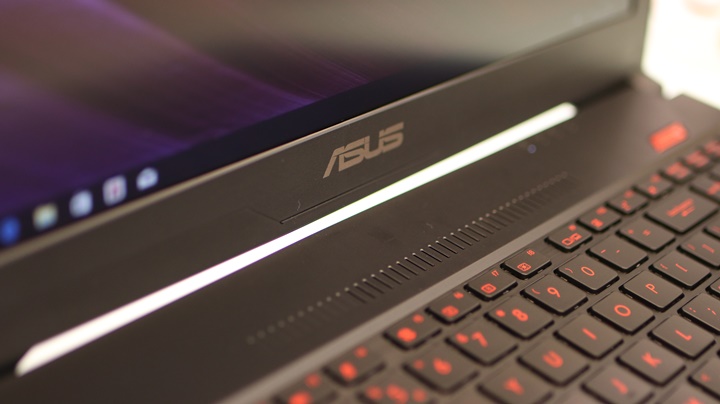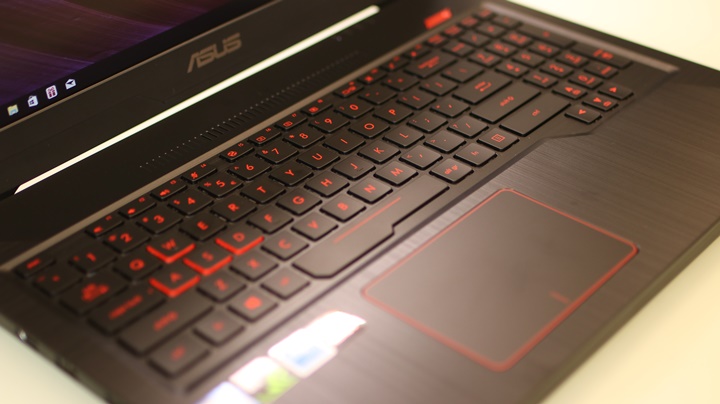In the spectrum of gaming laptops, ASUS is perhaps best known for those that fall under the Republic of Gamers brand, which as you can definitely tell by the name, is catered directly towards gamers. The designs of these laptops are somewhere in between stealthy and aggressive and are plastered with all the RGB lighting you could want. If you don’t want (or need) anything that flashy though, ASUS’ FX series exists as an alternative that doesn’t carry the bells and whistles but packs the specs you need to game.

Last year, we reviewed the ASUS FX502 which was, in my opinion, the best choice we had for a GTX 1060-carrying laptop for the price. We even gave it the Editors’ Choice award for Best Value Gaming Laptop at YCA 2017. Does the FX503 carry the same mantle? Let’s find out.
Table of Contents
At first glance, the FX503 is definitely a lot more stealthy-looking than most gamer-centric laptops, but you still know it’s a gaming laptop, especially due to the red accents, and particularly due to the prominence of the WASD keys.

Its construction is largely made up of tough plastic, but is really nice to the touch and easy on the eyes because of the brushed aluminum look. The hinge is fairly stable, and a one-hand lift is doable, though this is likely just due to the sheer weight of the bottom half. Overall, it’s a pretty hefty machine, but it’s definitely not a thick, heavy, uncomfortable-to-carry beast.

Compared with the FX502, the bezels here do seem slightly shrunken down, which is always a plus. They’re still quite big though, but this is pardonable since the display type and specs on a gaming laptop are given a much higher priority, than how it actually fits into the overall design. Sitting at the top of the display is the webcam and microphone.


Moving on to I/O, we have a Kensington lock, USB 3.0 port, and full-size SD card reader on the right. On the left are the power input, RJ45 LAN, HDMI, two USB 3.0 ports, and combo audio port. You’re getting all you need here, but it would have been nice if there was a USB 3.1 Type-C port.

The chiclet-style keyboard is backlit with red lights, brightness is okay but without brightness adjustment, which would have been solid for saving battery. The arrow keys are in an odd position, though it’s actually a smart use of space to sort of combine it with the numpad.

The keys are generally well-spaced, but the feeling of the keys themselves is not that great. They have a bit too much travel and have an overall mushy feeling to them. Some gamers and touch-typists will have great difficulty appreciating the keyboard and will probably opt to plug in an external one.
Above the keyboard is a nice red power button, an air vent, and LED notification/status lights, which is nice. Below it is a very mediocre trackpad. The surface has an unpleasing, plasticky texture that isn’t so nice to the touch. Tracking feels equally unpleasant, getting jittery and flat-out making you want to use a mouse instead. It’s also not very big, and the click is mushy.

Still, the ASUS FX503 has a sturdy build and appealing design, which can probably lead people to look past its functionality flaws. There is little keyboard flex, and screen flex is there, but not enough to worry about it.
The FX503 uses a 15.6-inch Anti-Glare display with a resolution of 1080p and refresh rate of 60Hz. It’s your standard fare, no-frills display that will suffice for general use and will be enough for most gamers. It’s not the most color accurate of displays though, so creatives won’t be impressed. Still, it’s decent enough for everything else. It’s bright enough for most situations and viewing angles are pretty good.

ASUS laptops are somewhat underrated when it comes to speakers, and the FX503 is no exception. They can get very loud without losing clarity, and they feel like they’re firing right at you, which shows that they are positioned well. There is a tiny hint of strength in the bass, but it won’t knock your socks off. Overall, it’s a treat for watching movies or listening to music.
The configuration of this particular FX503 has an Intel Core i7-7700HQ processor, NVIDIA GeForce GTX 1060 6GB, 4GB of DDR4 SDRAM, and a 1TB/8GB 5400RPM FireCuda SSHD.
Now, the first half of that last sentence sounds great, but once you get to “4GB of DDR4 SDRAM”, you may start to scratch your head a little bit. Yes, you can easily upgrade all the way up to 32GB, but why only include 4GB in the first place when the machine is rocking an i7 and GTX 1060? It really baffles us, and both performance and general use suffer from this bottleneck.

Also, if an SSD + HDD combo is too much to ask for at this price range, it would have definitely made more sense to opt for a quality 7200RPM HDD instead of the included 5400RPM SSHD, as disk usage in Windows 10 skyrocketed to 100%, similar to what we’ve seen in other systems that use a single 5400RPM drive.
General operation, such as startup, browsing the web with Chrome, and even navigating through folders was kind of sluggish, and definitely not what you’d expect. If you’re a prospective buyer of this laptop, please do set aside a little more money to upgrade the measly 4GB of RAM, as well as add an SSD.
We tested a few games and synthetic benchmarks at the highest settings, and performance were pretty decent overall, despite the RAM and storage limitations. Again, do not forget that this laptop is packing an i7-7700HQ and GTX 1060 6GB, so it’s really no slouch. It just needs a little upgrade to make it a very capable machine. Check out the results below.



We put the FX503 through a so-called thermal gauntlet, subjecting it to the Prime 95 and FurMark CPU and GPU stress tests. Note that these are artificial tests and do not reflect real-world usage.

The actual cooling system, particularly for the CPU, didn’t perform the best, as the 7700HQ’s hottest core reached 97°C at one point, before stabilizing at around 82°C. The GTX 1060 maxed out at 82°C as well, which also isn’t great. The fans were very loud during stress-testing and gaming, but we were surprised at how well the heat was dissipated.
Most of it was exhausted out the back and sides, and neither the keyboard or trackpad got uncomfortably hot, even during a run of FurMark. It’s a good thing to know, especially for a gamer, that the actual places where your hands go, won’t suddenly turn into a car seatbelt on a hot summer day.
Powering the FX503 is a 4-cell 64Wh battery, same as the FX502. We put it through our standard video loop test (1080p video played on loop, 50% brightness and volume), and results were similar to last year’s model, running for a little over 4 hours before reaching 0%.
Note that this type of test is not indicative of real-world battery performance, and not to expect to get a lot out of the battery when it comes to gaming on the go.
The ASUS FX503 definitely carries over the mantle of last year’s FX502, keeping a good design, build quality, and user experience, particularly in its thermal management and speakers.

The memory configuration of this particular variant still needs some love from the end-user, as 4GB of RAM and an SSHD is clearly not an ideal situation for a gaming laptop, most especially one that is powered by an i7-7700HQ and GTX 1060 6GB. It’s really strange.
Still, you get all you need overall, and this variant (FX503VM-E4070T) is still a great buy for anyone looking to get a 7th-gen i7/GTX 1060 device. Its true potential just has to be unlocked.
The ASUS FX503VM starts at Php49,995USD 852INR 72,223EUR 811CNY 6,204 for the Core i5, 4GB RAM, 1TB HDD, GTX 1050 model; while the Core i7 variant with GTX 1060 (FX503VM-E4070T) starts at Php69,995USD 1,193INR 101,115EUR 1,136CNY 8,686. The i7 + GTX 1060 model is exclusively available at Complink stores nationwide, while the i5 + GTX 1050 model available at ROG stores.
ASUS FX503VM specs:
15.6-inch FHD (1920 x 1080) Anti-Glare Panel
Intel Core i5/i7 processor
NVIDIA GeForce GTX 1050 / GTX 1060 with 6GB GDDR5
4GB DDR4 2400MHz SDRAM up to 32GB
SATA 1TB 2.5? HDD (FireCuda)
Windows 10 (64-bit)
Backlit chiclet keyboard
1280 x 720 webcam
SD card reader
Speakers powered by ICEpower technology
3x USB 3.0
1x Headphone-out & Audio-in Combo Jack
1x RJ45 LAN
1x HDMI port
1x Kensington Lock
WiFi 802.11ac
Bluetooth 4.0
4 Cells 64 Whrs Battery
384 x 262 x 24 mm
2.20kg
What we liked about it:
What we didn’t:

YugaTech.com is the largest and longest-running technology site in the Philippines. Originally established in October 2002, the site was transformed into a full-fledged technology platform in 2005.
How to transfer, withdraw money from PayPal to GCash
Prices of Starlink satellite in the Philippines
Install Google GBox to Huawei smartphones
Pag-IBIG MP2 online application
How to check PhilHealth contributions online
How to find your SIM card serial number
Globe, PLDT, Converge, Sky: Unli fiber internet plans compared
10 biggest games in the Google Play Store
LTO periodic medical exam for 10-year licenses
Netflix codes to unlock hidden TV shows, movies
Apple, Asus, Cherry Mobile, Huawei, LG, Nokia, Oppo, Samsung, Sony, Vivo, Xiaomi, Lenovo, Infinix Mobile, Pocophone, Honor, iPhone, OnePlus, Tecno, Realme, HTC, Gionee, Kata, IQ00, Redmi, Razer, CloudFone, Motorola, Panasonic, TCL, Wiko
Best Android smartphones between PHP 20,000 - 25,000
Smartphones under PHP 10,000 in the Philippines
Smartphones under PHP 12K Philippines
Best smartphones for kids under PHP 7,000
Smartphones under PHP 15,000 in the Philippines
Best Android smartphones between PHP 15,000 - 20,000
Smartphones under PHP 20,000 in the Philippines
Most affordable 5G phones in the Philippines under PHP 20K
5G smartphones in the Philippines under PHP 16K
Smartphone pricelist Philippines 2024
Smartphone pricelist Philippines 2023
Smartphone pricelist Philippines 2022
Smartphone pricelist Philippines 2021
Smartphone pricelist Philippines 2020
Kenneth M. says:
How about the ASUS ROG Strix GL503 i5-7300HQ NVIDIA with 2GB/4GB GDDR5 VRAM GeForce GTX 1050 with 64 Whrs 4 Cells Battery, do you have a review of this unit? How many hours of gaming before it reach 0%? Medium-HD video settings and medium-high audio settings.
Jiovanni says:
To the author of this article, please clarify us with the processor in FX 503. There’s loads of i5 and i7 SKUs. Tell us the exact model. It’s vague.
magne says:
4GB is the result of adding a mid to high endish GPU – GTX 1060 and an i7, these two alone costs more than half the laptop. Sacrifice the easier to upgrade parts for the latest gpu and cpu. That is every gamer’s desire.